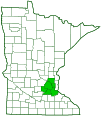viburnum leaf beetle
(Pyrrhalta viburni)
Conservation • Description • Habitat • Ecology • Distribution • Taxonomy
|
|
||||||||||||||
Description |
Viburnum leaf beetle is an exotic, small, skeletonizing leaf beetle. It is often referred to as VLB, but only in “fact sheets” or other publications about insect pests. It is native to Europe and was introduced into the New World. It was first collected in North America in Fonthill, Ontario in 1947, but it was not problematic at that time. Specimens were collected in 1924 in Annapolis Royal, Nova Scotia. Annapolis Royal was one of the earliest European settlements in North America. It was also the location of the largest horticultural nursery between 1885 to about 1945. Viburnum leaf beetle may have been imported with horticultural stock imported from Europe, and then sold throughout the Maritime Provinces. Alternatively, it could have been imported during the early history of the settlement. In 1978, viburnum leaf beetle was discovered in Ottawa, Ontario and Hull, Quebec. By that time, it had been established at both locations for several years. In the United States, it was first discovered in Maine in 1994. The first sighting in Minnesota was on June 23, 2020, in Theodore Wirth Regional Park in Minneapolis. It now occurs in the United States from Maine to northern Virginia, west to Minnesota and northern Illinois. It also occurs in northwestern Washington. It occurs in southern Canada from Nova Scotia to Ontario and in British Columbia. In Minnesota it has been reported only in the Metro region. Research has shown that the eggs require a long winter, and that will limit the species’ southward expansion. Adults and larvae are food specialists, feeding on the leaves of Viburnum. They have been reported on all five Viburnum species that occur in Minnesota except squashberry (Viburnum edule). The larvae feed in spring. They chew holes in the leaves between the veins, leaving a lace-like (skeletonized) pattern. The adults feed in summer. They chew circular to elliptical holes in the leaves. A heavy infestation of VLB can completely defoliate a plant, causing reduced vigor or death of the plant. Adults are 3⁄16″ to ¼″ (4.5 to 6.5 mm) in length. The body is yellowish brown and tinged with black. It is elongate oval when viewed from above, convex when viewed from the side. The head, the plate covering the first segment of the thorax (pronotum), and the wing covers (elytra) are densely covered with shiny golden hairs. The hairs give the body a golden sheen in different areas when viewed at different angles. The head is visible from above and is nearly as wide as the pronotum. There is a large black spot on the top of the head. The antennae have 11 segments and are about half as long as the body. The second segment is long and black. The fourth segment is longer than the second. The third through eleventh segments are yellowish at the base, grading to black at the tip. The antennae bases are between the eyes. The eyes are not notched. The mouthparts are directed downwards. The pronotum is two times wider than long, and it has distinct flattened lateral margins. The rear is slightly narrower than the base of the elytra. There is a dark longitudinal stripe in the middle and another on each lateral margin. The elytra have no dark stripes, but the shoulders are often darkened. The surface is dotted with fine pits (punctate). On both sexes, the fourth segment (tibia) of the hind legs has a pair of spurs at the tip. The last part of each leg (tarsus), corresponding to the foot, has five segments. The fourth segment is very short and is concealed within the broadened tip of the third segment, making the tarsus appear to have only four segments. |
Size |
Total length: 3⁄16″ to ¼″ (4.5 to 6.5 mm) |
Similar Species |
Habitat |
|
Ecology |
Season |
One generation per year: summer |
Behavior |
|
Life Cycle |
The female chews into a twig, creates a cavity in the soft inner tissue (pith), and lays 5 to 6 eggs. She then seals the cavity with her own excrement. She can lay up to 500 eggs in her lifetime. The eggs overwinter and hatch in early to mid-May the following spring. In early to mid-June, mature larvae drop to the ground and pupate in the soil. Adults emerge by late June or early July. |
Larva Food |
Leaves of several Viburnum species |
Adult Food |
Leaves of several Viburnum species |
Damage |
The larvae chew holes in the leaves between the veins, leaving a lace-like (skeletonized) pattern. The adults chew circular to elliptical holes in the leaves. A heavy infestation of VLB can completely defoliate a plant, causing reduced vigor or the death of the plant. |
Distribution |
||
|
Sources |
|
| 5/26/2024 | ||
Occurrence |
||
Uncommon in Minnesota |
||
Taxonomy |
|
Order |
Coleoptera (Beetles) |
Suborder |
Polyphaga (Water, Rove, Scarab, Long-horned, Leaf, and Snout Beetles) |
Infraorder |
Cucujiformia |
Superfamily |
Chrysomeloidea (leaf beetles and allies) |
Family |
Chrysomelidae (leaf beetles) |
Subfamily |
Galerucinae (skeletonizing leaf and flea beetles) |
Tribe |
Galerucini |
Genus |
Pyrrhalta |
Subordinate Taxa |
|
|
|
Synonyms |
|
Galeruca viburni Galerucella viburni Tricholochmaea viburni |
|
Common Names |
|
viburnum leaf beetle |
|
Glossary
Elytra
The hardened or leathery forewings of beetles used to protect the fragile hindwings, which are used for flying. Singular: elytron.
Pronotum
The exoskeletal plate on the upper side of the first segment of the thorax of an insect.
Punctate
Dotted with pits (punctures), translucent sunken glands, or colored spots of pigment.
Tarsus
On insects, the last two to five subdivisions of the leg, attached to the tibia; the foot. On spiders, the last segment of the leg. Plural: tarsi.
Visitor Photos |
||
Share your photo of this insect. |
||
This button not working for you? |
||
Alfredo Colon |
||
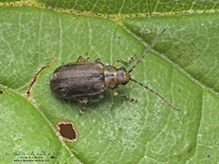 |
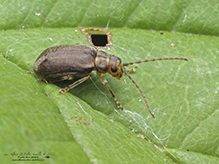 |
|
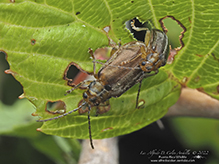 |
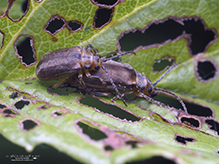 |
|
MinnesotaSeasons.com Photos |
||
|
||
|
||

Visitor Videos |
||
Share your video of this insect. |
||
This button not working for you? |
||
|
Other Videos |
||
Viburnum beetle |
About
Jun 10, 2023 The Viburnum beetle (Pyrrhalta viburni) is a royal pain at times. While most cases it isn't the end of the world, heavy infestations can kill even the strongest plant! They are common here in the UK and I just found that I have a few larvae on my Winter-flowering Viburnum. Crushing them is the easiest way to get rid of them, but you can also blast them off with a hosepipe or you can kill them with a systemic pesticide. I personally would choose that option only in the heaviest infestations. But it is still an option. |
Viburnum leaf beetle larvae feeding |
About
Jul 27, 2012 This 5 day, 18 hour time lapse movie begins with newly hatched larvae of viburnum leaf beetle (Pyrrhalta viburni) feeding on an arrowwood leaf (Viburnum dentatum), one of their preferred hosts. The larvae feed gregariously and skeletonize viburnum foliage, leaving only midribs and major veins intact. Images were taken at 5 minute intervals. |

Visitor Sightings |
||
Report a sighting of this insect. |
||
This button not working for you? |
||
Shannon Gabriel-Griggs |
Location: Eagan, MN larvae present |
| Alfredo Colon 8/15/2022 |
Location: Albany, NY |
 |
| Alfredo Colon 8/12/2022 |
Location: Albany, NY |
 |
| Alfredo Colon 8/2/2022 |
Location: Albany, NY |
 |
MinnesotaSeasons.com Sightings |
||
|

Created: 1/10/2024 Last Updated: © MinnesotaSeasons.com. All rights reserved. |
